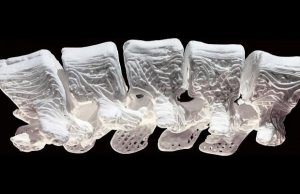 Bone implants are used in medicine for several years, they are still rejected by the body and are not suitable for children, because they will have to undergo several more operations as they grow up. In addition, they are more fragile than ordinary human bones and are often extremely expensive.
Bone implants are used in medicine for several years, they are still rejected by the body and are not suitable for children, because they will have to undergo several more operations as they grow up. In addition, they are more fragile than ordinary human bones and are often extremely expensive.
Fortunately, 3D printing technologies can help to find a solution, stimulating the restoration of bone cells. Several groups of researchers around the world are looking for material to create a framework in which stem cells can develop.
Scientists from Northwestern University under the direction of Ramilla Shah proposed the latest development – the technology of “hyper-elastic bones” . This technology, in the opinion of many experts, may become a universal solution to a variety of problems.
It is a question of hyperelastic biochernil, from which it is possible to print bone implants of any size and shape. The material allows doctors to transplant the patient an implant of a strictly necessary shape. After the operation, the cellular structure and the vessels that promote the restoration of bone tissue will develop in the framework.
Ramilla Shah has been researching 3D printing for years, but hyperelastic bones are her most significant achievement to date. According to Shah, the elasticity of the material surprised even the researchers themselves – after any deformation, it takes the original shape. The team calculates that this technology can be used in hospitals where an individual implant can be manufactured in 24 hours based on scanning the patient’s bones.
Hyperelastic bones, for the most part, consist of a hydroxyapatite mineral that is contained in human bones. This material is still used in surgery, but its drawback is increased fragility. However, in combination with the polymer, it becomes extremely flexible and suitable for 3D printing. Due to the high content of hydroxyapatite, the cells react to its bioactivity – the stem cells in this skeleton are transformed into bone tissue simply by the material used, without additional growth factors. Elasticity of the material is especially important for use in pediatrics – it can stretch together with the body. In addition, 3D printing of bone implants using the new technology is carried out at room temperature, which allows the addition of other substances, even antibiotics, to the material – this will reduce the risk of infection after surgery.
While new material was tested only in animals. It is used in the treatment of spine defects and injuries to the skull of rats and monkeys. Clinical trials in humans will begin within the next five years. Scientists have already conducted experiments in the laboratory with human stem cells, placing them in a frame of hyperelastic bones. As a result, not only the growth and development of cells was observed, but also the process of producing its own bone minerals.
In addition to other advantages, the new material is inexpensive to produce and can be stored for up to a year – this will allow sending it for use in remote areas, without the need for on-site production. Perhaps, it is this development that will be an ideal solution for creating bone implants.
Image Credit: Northwestern University
